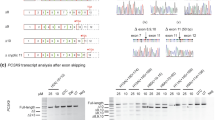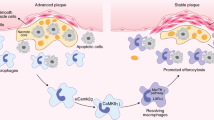Abstract
Apo(a) is a very atherogenic plasma protein without apparent function, which is highly expressed in humans. The variation in plasma Lp(a) concentration among individuals is considerable. Approximately 10–15% of the white population exhibit plasma Lp(a) concentrations above the atherogenic cut-off value of approximately 30 mg/dl. Since there is currently no safe way of treating those patients with drugs, we have tested the possibility of interfering with apo(a) biosynthesis by adenovirus-mediated expression of antisense apo(a) mRNA comprising the 5′ UTR, the signal sequence and the first three kringles of native apo(a). Transduction of rat hepatoma McA RH 7777 cells which stably expressed apo(a) with 18 kringle IV (KIV) domains with apo(a)-antisense adenovirus (AS-Ad) at multiplicity of infection (MOI) of 30 reduced apo(a) synthesis to 23% as compared with control cells. As apo(a) is not synthesized in laboratory animals, we induced biosynthesis of the N-terminal fragments of apo(a) in mice by adenovirus-mediated gene transfer. Cotransduction of these mice with AS-Ad, which expressed up to eight times higher amounts of apo(a) than stable transgenic apo(a) mice, led to an almost complete disappearance of apo(a) from plasma. We conclude that the proposed AS-construct is very efficient in interfering with apo(a) biosynthesis in vivo. The strategy of inducing the synthesis of a nonexpressed protein followed by knocking it out by AS technology may also be applicable to other systems.
This is a preview of subscription content, access via your institution
Access options
Subscribe to this journal
Receive 12 print issues and online access
$259.00 per year
only $21.58 per issue
Buy this article
- Purchase on Springer Link
- Instant access to full article PDF
Prices may be subject to local taxes which are calculated during checkout




Similar content being viewed by others
References
Kostner GM, Krempler F . Lipoprotein(a) Curr Opin Lipidol 1992 3: 279–284
Kostner GM et al. Lipoprotein Lp(a) and the risk for myocardial infarction Atherosclerosis 1981 38: 51–61
Budde T et al. Plasma Lp(a) levels correlate with number, severity, and length-extension of coronary lesions in male patients undergoing coronary arteriography for clinically suspected coronary atherosclerosis Arterioscler Thromb 1994 14: 1730–1736
Rader DJ et al. The inverse association of plasma lipoprotein(a) concentrations with apolipoprotein(a) isoform size is not due to differences in Lp(a) catabolism but to differences in production rate J Clin Invest 1994 93: 2758–2763
Utermann G . Lipoprotein(a). In: Scriver CR, Beaudet AL, Sly WS, Valle D (eds) The Metabolic and Molecular Bases of Inherited Disease McGraw Hill: New York 1995 1887–1912
McLean JW et al. cDNA sequence of human apo-lipoprotein(a) is homologous to plasminogen Nature 1987 330: 132–137
Morrisett J, Gaubatz J, Knapp R, Guevara JG . Structural properties of apo(a): a major apoprotein of human lipoprotein(a). In: Scanu A (ed.) Lipoprotein(a) Academic Press: San Diego 1990 53–72
Lackner C, Cohen JC, Hobbs HH . Molecular definition of the extreme size polymorphism in apolipoprotein(a) Hum Mol Genet 1993 2: 933–940
Van der Hoeck YY et al. The apoprotein(a) kringle IV repeats which differ from the major repeat kringle are present in variably-sized isoforms Hum Mol Genet 1993 2: 361–366
Craig WY et al. Lipoprotein(a) as a risk factor for ischemic heart disease: metaanalysis of prospective studies Clin Chem 1998 44: 2301–2306
Lawn R et al. Atherogenesis in transgenic mice expressing human apolipoprotein(a) Nature 1992 360: 670–672
Callow M et al. Atherogenesis in transgenic mice with human apolipoprotein B and lipoprotein(a) J Clin Invest 1995 96: 1639–1646
Grainger DJ et al. Activation of transforming growth factor-β is inhibited in transgenic apolipoprotein(a) mice Nature 1994 370: 460–462
Lawn RM et al. Feedback mechanism of focal vascular lesion formation in transgenic apolipoprotein(a) mice J Biol Chem 1996 271: 31367–31371
Kostner GM et al. HMG CoA reductase inhibitors lower LDL cholesterol without reducing Lp(a) levels Circulation 1989 80: 1313–1319
Carlson LA, Hamsten A, Asplund A . Pronounced lowering of serum levels of lipoprotein Lp(a) in hyperlipidaemic subjects treated with nicotinic acid J Intern Med 1989 226: 271–276
Seed M et al. The effect of nicotinic acid and acipimox on lipoprotein(a) concentration and turnover Atherosclerosis 1993 101: 61–68
Albers JJ et al. Reduction of lecithin cholesterol acyltransferase, apolipoprotein D and the LP(a) lipoprotein with the anabolic sterol stanazolol Biochim Biophys Acta 1994 795: 293–296
Kagawa A et al. Aspirin reduces apolipoprotein(a) (apo((a)) production in human hepatocytes by suppression of apo(a) gene transcription J Biol Chem 1999 274: 34111–34115
Robertson HD . Escherichia coli ribonuclease III cleavage sites Cell 1982 30: 669–672
Abou Elela S, Igel H, Ares JrM . RNase III cleaves eukaryotic preribosomal RNA at a U3 snoRNP-dependent site Cell 1996 85: 115–124
Rotondo G, Frendewey D . Purification and characterization of the Pac1 ribonuclease of Schizosaccharomyces pombe Nucleic Acids Res 1996 24: 2377–2386
Lozier JN, Metzger ME, Donahue RE, Morgan RA . Adenovirus-mediated expression of human coagulation factor IX in the rhesus macaque is associated with dose-limiting toxicity Blood 1999 94: 3968–3975
Lehrman S . Virus treatment questioned after gene therapy death Nature 1999 401: 517–518
Kochanek S . High-capacity adenoviral vectors for gene transfer and somatic gene therapy Hum Gene Ther 1999 10: 2451–2459
Morral N et al. High doses of a helper-dependent adenoviral vector yield supraphysiological levels of α1-antitrypsin with negligible toxicity Hum Gene Ther 1998 9: 2709–2716
Sugano M, Makino N . Changes in plasma lipoprotein cholesterol levels by antisense oligodeoxynucleotides against cholesteryl ester transfer protein in cholesterol-fed rabbits J Biol Chem 1995 271: 19080–19083
Frank S, Kostner GM . The role of apo(a) kringle IVs in the assembly of lipoprotein(a) Protein Eng 1997 3: 291–298
Frank S et al. Effect of tranexamic acid and ∂-aminovaleric acid on lipoprotein(a) metabolism in transgenic mice Biochim Biophys Acta 1999 1438: 99–110
Kobayashi K et al. Reversal of hypercholesterolemia in low density lipoprotein receptor knockout mice by adenovirus-mediated gene transfer of the very low density lipoprotein receptor J Biol Chem 1996 271: 6852–6860
McGrory WJ, Bautista DS, Graham FL . A simple technique for the rescue of early region I mutations into infectious human adenovirus type 5 Virology 1988 163: 614–617
Graham FL, van der Eb AJ . A new technique for the assay of infectivity of human adenovirus IV DNA Virology 1973 52: 456–467
Teng B et al. Adenovirus-mediated gene transfer of a rat apolipoprotein B mRNA-editing protein in mice virtually eliminates apolipoprotein B-100 and normal low density lipoprotein production J Biol Chem 1994 269: 29395–29404
Frank S, Durovic S, Kostner GM . Structural requirements of apo(a) for the lipoprotein(a) assembly Biochem J 1994 304: 27–30
Acknowledgements
This work was supported by grants from the Austrian Research Foundation SFB 702 and the Austrian National Bank ÖNB #7475. The technical assistance of Harald Grillhofer, Margit Eichholzer and Anton Ibovnik is highly appreciated.
Author information
Authors and Affiliations
Rights and permissions
About this article
Cite this article
Frank, S., Gauster, M., Strauss, J. et al. Adenovirus-mediated apo(a)-antisense-RNA expression efficiently inhibits apo(a) synthesis in vitro and in vivo. Gene Ther 8, 425–430 (2001). https://doi.org/10.1038/sj.gt.3301434
Received:
Accepted:
Published:
Issue Date:
DOI: https://doi.org/10.1038/sj.gt.3301434
Keywords
This article is cited by
-
A Designed Zinc-finger Transcriptional Repressor of Phospholamban Improves Function of the Failing Heart
Molecular Therapy (2012)
-
Lipoprotein(a) and the atherothrombotic process: Mechanistic insights and clinical implications
Current Atherosclerosis Reports (2003)



